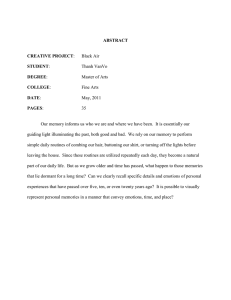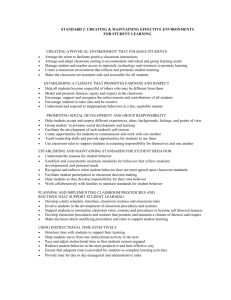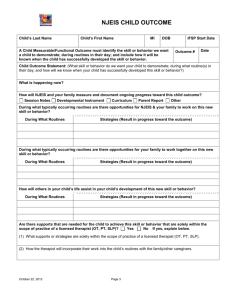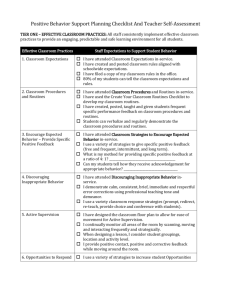Tutorial 3: Classroom Management Introduction
advertisement
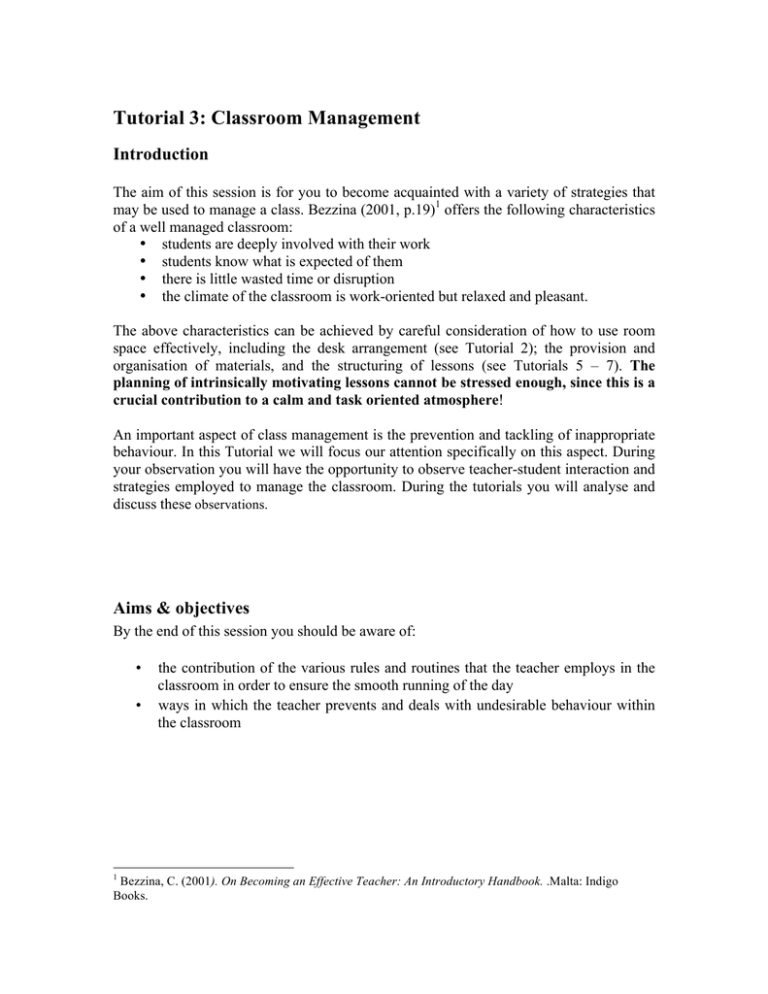
Tutorial 3: Classroom Management Introduction The aim of this session is for you to become acquainted with a variety of strategies that may be used to manage a class. Bezzina (2001, p.19)1 offers the following characteristics of a well managed classroom: • students are deeply involved with their work • students know what is expected of them • there is little wasted time or disruption • the climate of the classroom is work-oriented but relaxed and pleasant. The above characteristics can be achieved by careful consideration of how to use room space effectively, including the desk arrangement (see Tutorial 2); the provision and organisation of materials, and the structuring of lessons (see Tutorials 5 – 7). The planning of intrinsically motivating lessons cannot be stressed enough, since this is a crucial contribution to a calm and task oriented atmosphere! An important aspect of class management is the prevention and tackling of inappropriate behaviour. In this Tutorial we will focus our attention specifically on this aspect. During your observation you will have the opportunity to observe teacher-student interaction and strategies employed to manage the classroom. During the tutorials you will analyse and discuss these observations. Aims & objectives By the end of this session you should be aware of: • • 1 the contribution of the various rules and routines that the teacher employs in the classroom in order to ensure the smooth running of the day ways in which the teacher prevents and deals with undesirable behaviour within the classroom Bezzina, C. (2001). On Becoming an Effective Teacher: An Introductory Handbook. .Malta: Indigo Books. Issues to consider Classroom routines Routines are established procedures that direct and coordinate how students move and how events occur (Cruickshank et al, 2003)2. In Tutorial 2, you became aware of some rules and routines. In this tutorial you will continue to reflect on these in more detail in order to appreciate their contribution to ensuring a calm learning environment. If students are familiar with the processes necessary to get a particular task done, they are more likely to complete it in an orderly manner. Cruickshank et al (ibid) suggest that there are three types of classroom routines: • Management routines. These involve non-academic matters such as the distribution of copybook and transitions between activities. (For example, the students know that the day always begins with the collection of homework, or that between two lessons, the textbooks on their desks should be changed). • Activity routines. These spell out how each kind of activity will be conducted in terms of location, duration, participants and materials. (For example, computer work is carried out in pairs; Art lessons are held in the Art room and require tidying up afterwards). • Instructional routines. These refer to what the teacher will do while teaching; such routines relate to the teacher’s own style of teaching and render the flow of the lesson more predictable and efficient. (For example, the children know that the teacher likes to start a Religion lesson with a discussion, or to include in a mini-whiteboard activity in a maths lesson). 1. List/mention examples of the above types of routines involved in classroom management. 2. Have you noted any of the above mentioned routines in action during your previous visits to the class? Do you think the routines were effective? Monitoring Students’ Behaviour Traditionally, classroom management has focused on how teachers react after students misbehave; that is, the emphasis was on discipline (Cruikshank et al, 2003). For today’s classroom, management should include both proactive (preventive) and reactive (disciplinary) management strategies (Cruikshank et al (ibid p.382). 2 Cruickshank, D. R., Bainer Jenkins, D. and Metcalf, K.K. (2003). The Act of Teaching. Boston: McGrawHill. Proactive strategies include routines for movement around the class and rules for positive behaviour. Bezzina (2001, p.38) lists some features of good rules: • A rule should be clear, specific and easy to follow • A rule should be simply stated • A rule should deal with observable behaviour • A rule should have a penalty for breaking it! Cruikshank et al (2001) suggest that a rule is best stated positively rather than negatively. For example, “Listen carefully when the teacher is explaining” is better than “Don’t talk while the teaching is explaining”. While it is helpful to have the rules written on a chart, they lose their effectiveness if not enforced. Never give an instruction that you don’t mean to enforce! Rewards and positive reinforcements can also be helpful in maintaining appropriate behaviour. Two examples of strategies are praising appropriate behaviour or awarding stickers for effort. Reactive strategies are sometimes necessary when, despite the teacher’s effort to manage the classroom positively, a child acts in an inappropriate way. An effective teacher deals with misbehaviour as quickly as possible, although sometimes it may be best to ignore a minor distraction. Some ways of reacting are the following: shaking your head, making eye contact, using facial expressions, moving closer, gesturing and so on (Cruikshank et al, 2001). Teachers sometimes choose to use verbal reprimands or a ‘time-out’ strategy. However, Cruikshank et al advise that, in general, punishment should be used sparingly and after careful consideration. Furthermore, it should be in relation to the inappropriate behaviour. (For example, the act of disrupting a group work activity might be punished by asking the student to compensate for the work). If unrelated, punishments maybe seen by the student to be arbitrary and the teacher may be considered to be ‘unfair’. 1. Why is it important that a code of appropriate behaviour is established in the classroom? 2. What rules would be suitable for Early Years children? For middle and upper Primary children? 3. What reasons might there be for a student misbehaving? 4. List some proactive strategies that a teacher might use. 5. List some reactive strategies that a teacher might use. Observation tasks and activities Classroom routines 1. Observe, describe and reflect on the effectiveness of the various routines used in the classroom. Distinguish between management, activity and instructional routines. 2. Ask the teacher why she/he finds these routines helpful. 3. What would you do differently if you were in charge of the class? Monitoring Students’ Behaviour 1. Are classroom rules posted anywhere in the classroom? Are they clear and positively formulated? Speak to the teacher about the written or unwritten class rules. (How were they developed and established? Does she/he consider them effective?) 2. Reflect on the proactive strategies your class teacher implements in order to manage the class. 3. Note any reactive strategies used by the teacher in particular situations. Do you consider them to be effective? What other strategy might you have used in these situations? 4. Ask the teacher her/his advice about how to cope generally with inappropriate behaviour. She/he might refer to a particular student in the class you are observing and/or draw on previous experiences with other classes. 5. With the teacher’s permission ask a few students about their classroom rules. If these are not written, then you might mention some rules to them based on your observations and /or teacher’s feedback regarding class rules. (e.g. Do they know what the class rules are? Do they feel that the rules are necessary? Do they find the rules difficult to adhere to? How do they feel when classmates do not follow the rules?). 6. How is bullying dealt with by the teacher/the school?

